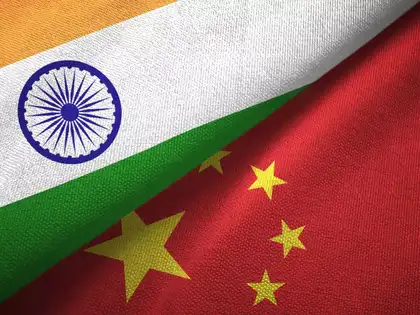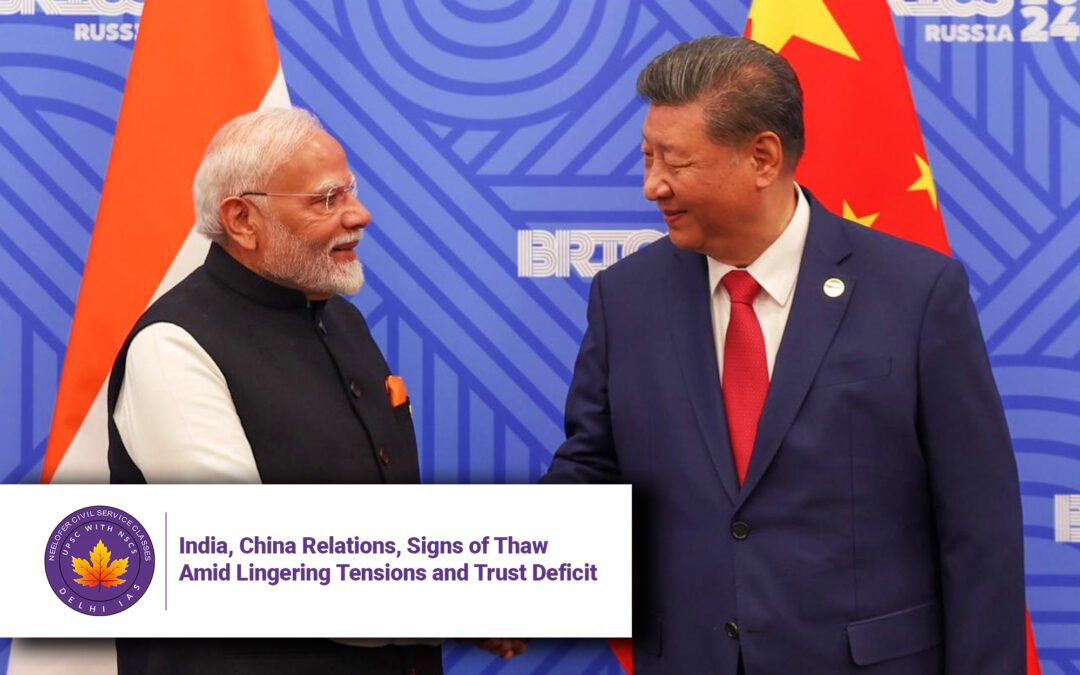India, China Relations, Signs of Thaw Amid Lingering Tensions and Trust Deficit
Why in News?
India’s recent move to resume issuing tourist visas to Chinese nationals marks a significant step in the process of normalizing bilateral ties that had sharply deteriorated following the 2020 military standoff in Ladakh. The development is one among several indicators suggesting that India-China diplomacy is gradually regaining traction after nearly five years of strain post the Galwan Valley clash. However, despite this cautious engagement, key strategic differences and deep-rooted mistrust continue to plague the relationship. 
This current development, announced just weeks before Prime Minister Narendra Modi’s expected visit to Kazakhstan for the Shanghai Cooperation Organisation (SCO) Summit, has renewed global focus on the trajectory of India-China ties.
Background: The 2020 Standoff and Breakdown in Relations
Tensions between India and China reached a historic low in 2020, when soldiers from both countries clashed in the Galwan Valley, leading to the death of 20 Indian and several Chinese soldiers. This violent episode, the first of its kind in 45 years along the Line of Actual Control (LAC), significantly disrupted diplomatic, economic, and cultural engagement between the two Asian giants.
India responded by:
-
Imposing restrictions on Chinese investment.
-
Banning over 250 Chinese mobile applications.
-
Halting the issuance of visas for Chinese nationals, including students and tourists.
-
Strengthening defence infrastructure and troop presence in Ladakh.
China, in turn, introduced export restrictions on critical commodities such as fertilizers and rare earth minerals, creating ripple effects in sectors heavily reliant on imports.
Recent Developments and Diplomatic Signals
The Indian government’s decision to reopen tourist visa services for Chinese citizens reflects a softening of its stance. It follows several important bilateral moves, including:
-
China reopening the Kailash Mansarovar Yatra pilgrimage for Indian nationals.
-
Resumption of meetings under the Working Mechanism for Consultation and Coordination on India-China Border Affairs (WMCC)—held three times in recent months.
-
A joint statement indicating plans to resume direct flights and potentially reopen journalist visa processing.
-
Agreement to restart “functional dialogues” on economic and trade issues.
These moves indicate that both sides are seeking to revive normal diplomatic channels and ease logistical and people-to-people ties, particularly in preparation for upcoming multilateral summits.
Strategic and Economic Considerations
India and China share a $125+ billion bilateral trade relationship. However, trade dynamics have been deeply skewed in China’s favor, with India running a massive deficit. The economic impact of China’s export restrictions, especially on fertilizers and critical minerals needed by Indian technology companies, has been notable:
-
Japanese and Korean car manufacturers in India have raised alarm over potential supply chain disruptions.
-
The Indian electronics and renewable energy sectors, heavily reliant on Chinese components, have experienced uncertainty.
These dependencies are forcing India to reconsider whether complete economic decoupling is feasible. The new dialogues on economic ties may help revise investment regulations and restore trade balances, though much depends on mutual political trust.
The Trust Deficit: A Core Challenge
Despite these developments, trust between the two nations remains fragile. Since the 2020 crisis, neither side has made transparent public disclosures about:
-
What led the Chinese People’s Liberation Army (PLA) to cross the LAC.
-
What guarantees, if any, exist to prevent future military escalations.
-
Why critical de-escalation and disengagement efforts remain unfinished.
While both governments have resumed dialogue on some fronts, there is a conspicuous silence regarding the underlying issues that triggered the rupture in 2020.
India’s December 2024 statement in Parliament reiterated that “normalcy in ties can only be restored after peace and tranquility is restored in border areas.” However, the current developments suggest that New Delhi may now be willing to decouple political normalization from military disengagement, a move that could carry strategic risks.
Border and Military Concerns Still Unresolved
Though diplomatic contacts have resumed, the LAC remains tense in several areas:
-
Full troop disengagement has not been achieved in Hot Springs, Depsang Plains, and Demchok.
-
Chinese infrastructure building in disputed zones continues.
-
India’s efforts to ramp up its border road and tunnel infrastructure remain urgent.
The resumption of patrolling by Indian troops to areas previously accessible before 2020 is yet to occur. Buffer zones created during earlier disengagement talks are now semi-permanent, denying India full access to its traditional patrolling points.
Until the status quo ante of early 2020 is restored, India risks setting a dangerous precedent by normalizing ties without resolving the border standoff, potentially weakening its strategic deterrence.
The Tibet Factor: Mega-Dam on the Brahmaputra
Another concern aggravating mistrust is the construction of a mega-dam project by China on the Yarlung Tsangpo river (known as the Brahmaputra in India). New Delhi has flagged this issue multiple times, concerned about:
-
Possible water diversion impacts in downstream Assam and Arunachal Pradesh.
-
Environmental degradation and loss of riverine biodiversity.
-
Strategic control of India’s northeastern water flows by China.
China claims the project is hydroelectric and benign, but the opacity surrounding its plans, coupled with tensions on the border, makes the issue a strategic flashpoint. It was also a point of discussion in the latest WMCC meeting in Delhi.
Operation Sindoor and China-Pakistan Nexus
Further fueling Indian apprehension is the PLA’s growing cooperation with Pakistan’s military, as revealed during Operation Sindoor—an Indian military surveillance operation that confirmed the joint presence of PLA officers in Pakistan-occupied Kashmir (PoK).
India sees this as a two-front threat, with China possibly emboldening Pakistan’s stance in disputed regions. This undermines the trust required for sustained diplomatic engagement.
Such coordination adds a layer of complexity to India’s border security calculus and makes strategic compartmentalization even more difficult.
Looking Ahead: Strategic Calculations and Diplomacy
India appears to be adopting a calibrated, compartmentalized strategy, aiming to salvage trade and diplomatic ties while maintaining military caution. The government is preparing for:
-
The next Special Representatives meeting on border resolution.
-
PM Modi’s SCO Summit visit in Kazakhstan in August 2025.
-
Possible re-engagement under RCEP-like frameworks with stricter conditions.
-
Reopening educational, journalistic, and cultural exchanges in phases.
However, experts warn that this approach could backfire unless critical military issues are transparently addressed. Restoring tourism, flights, and visas without clarifying the terms of engagement at the LAC risks normalizing a frozen conflict.
Recommendations for a Balanced Re-Engagement
1. Prioritize Strategic Clarity
India must continue pressing China for:
-
Clear timelines for full disengagement and de-escalation.
-
Restoration of pre-2020 patrolling rights.
-
Disbandment of temporary buffer zones that limit Indian presence.
2. Insist on Transparency and Reciprocity
India should not resume full-fledged engagement without:
-
Assurances of transparency on infrastructure projects, including dams on shared rivers.
-
Reciprocal opening of journalist access, student visas, and diplomatic mobility.
-
Addressing cybersecurity and trade imbalance concerns.
3. Strengthen Multilateral Leverage
India must use forums like the SCO, BRICS, and the G20 to:
-
Build international pressure on China to honor border agreements.
-
Raise issues like transboundary water governance.
-
Reinforce norms around non-aggression and peaceful dispute resolution.
4. Diversify Economic Dependencies
The Galwan crisis highlighted India’s vulnerability to Chinese export restrictions. India should:
-
Invest in local mineral processing, particularly lithium and rare earths.
-
Partner with like-minded democracies for resilient supply chains.
-
Boost domestic production of fertilizers, electronics, and EV components.
Conclusion
The resumption of tourist visas, discussions on flight links, and renewed economic dialogues between India and China offer a glimmer of diplomatic hope after years of tension. However, this engagement should not come at the cost of strategic dilution.
Unless both countries squarely address the Galwan legacy, restore border peace, and build trust through transparency, these diplomatic overtures may prove fleeting. India must strike a careful balance between engagement and deterrence, ensuring that national security is not compromised in the name of normalcy.
The road to rebuilding trust with China will be long and fraught, but it must begin with acknowledging past transgressions, demanding accountability, and prioritizing national interests over optics.








